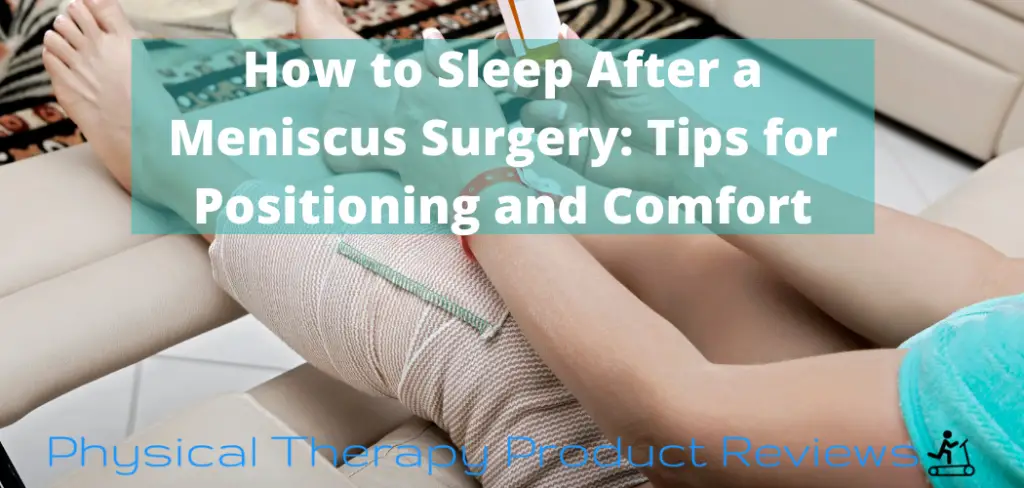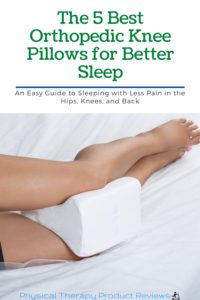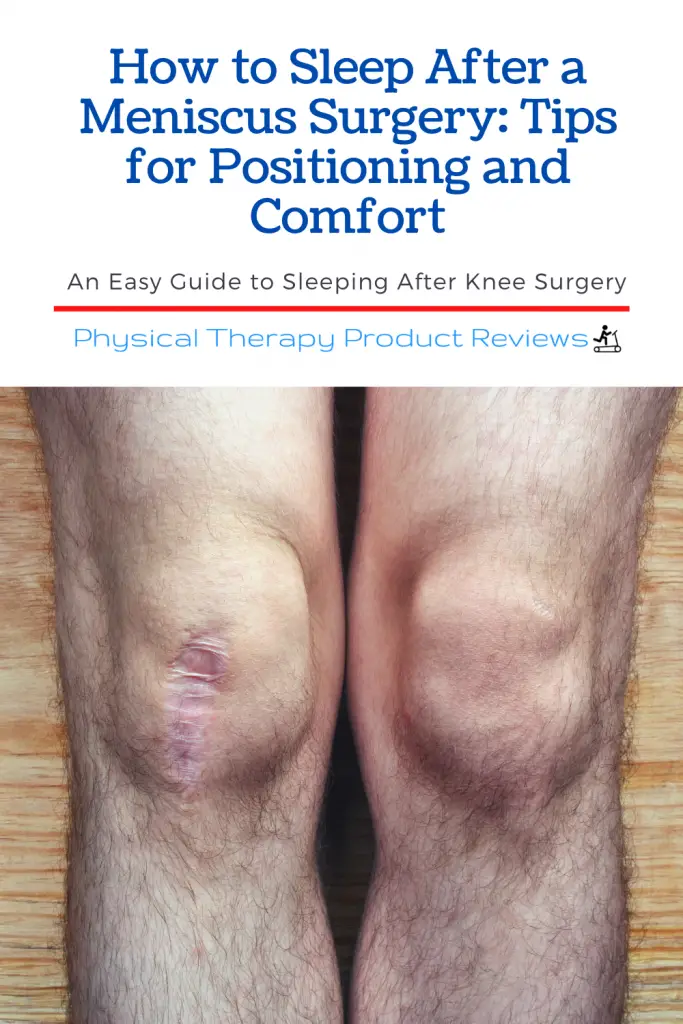
If you are one of the many people who have undergone meniscus surgery, sleeping may be on your mind. How can you get the most restful sleep possible? What position should your knee be in? What types of positions should you avoid?
When you get home from surgery, you want two things: to catch up on sleep and to protect the knee while it heals.
This article will review everything that involves sleeping after meniscus surgery and provide tips to help make the process as smooth as possible.
What Position Should You Sleep In After a Meniscus Surgery?
Our recommendation is to sleep on your back with your entire leg supported with a wedge or a stack of pillows so that it can be elevated, supported, and, most importantly, remain entirely straight through the night.
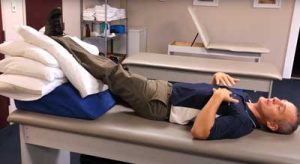
One of the most critical aspects of recovery after a meniscus surgery is getting proper sleep. The most critical position to sleep in is with the knee as straight as possible. This helps prevent muscle contracture and prevents scar tissue from forming and keeping the knee from achieving full extension.
A muscle contracture is when the muscle heals in a bent or flexed position and prevents the joint from achieving full knee extension.
Full knee extension is critical and the most important goal after knee surgery.
Therefore, when you are sleeping, you want to try and keep the leg straight while also getting as comfortable as you can to sleep through the night.
Tips for Finding a Comfortable Sleeping Position After a Meniscus Surgery
Below we share some simple tips to make sure that you can protect the newly operated knee and still find enough comfort to get some sleep.
Elevate the Leg To Decrease Swelling
One of the best sleeping positions to decrease swelling is by sleeping with your leg elevated.
We recommend propping up the operated leg on multiple pillows to keep it at or above the level of your heart.
This will help decrease any residual swelling that may still be present and also help prevent any new swelling from forming overnight.

You can stack pillows, blankets, or sleep in a recliner, or they even make special medical wedges that you can stack to elevate your leg.
If you try to sleep in a recliner after knee surgery, be sure to use more than just the leg rest to elevate the leg. The normal recline position isn’t high enough to drain much swelling.
Related Topic: The Best Orthopedic Wedge Pillows for Better Sleep
Place a Long Pillow Under the ENTIRE Leg
Another sleeping tip that can help with comfort and swelling is to place a long pillow under the entire leg.
This will help support the newly operated leg and keep it from bending at night.
It also puts less pressure on the operated knee, which can be helpful if you are still having pain around the incision site.
If you are having trouble sleeping on your back, placing a pillow underneath the operated leg can also help relieve any pain you may have and help keep the leg elevated.
Just be sure that the pillow is under the entire leg and not only behind the knee. This may cause a flexion contracture.
Use a Knee Pillow Between the Knees When You Sleep on the Side
If you are used to sleeping on your side, this may be the best position for you after meniscus surgery.
Just be sure to place a knee pillow between your knees when sleeping on your side. This will help take some of the pressure off the operated leg and help keep both legs aligned.
Use Ice or Heat Right Before Bed
If you have trouble sleeping due to pain, you may benefit from using ice or heat right before bed.
We recommend 20 minutes of either ice or heat. If you use heat, we recommend using a heating pad on the lowest setting or a warm towel.
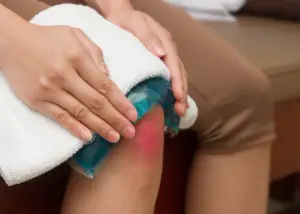
You can also try taking a hot bath right before bed to help you relax and ease any pain you may be having.
We have been using ice almost exclusively after surgeries to help decrease swelling in the past. However, recent research has shown that ice only delays swelling and may slow down healing.
Heat brings blood to the area and may help speed up the necessary and expected swelling. As long as your knee isn’t swollen to the pain of extreme pain, try using heat.
On the other hand, ice is significantly better at reducing pain levels and may be a better option immediately after surgery.
Walk or Ride a Bike in the Middle of the Night
If you are having trouble sleeping and are in a lot of pain, you may need to get up and walk around the house or ride a bike for a few minutes in the middle of the night.
We have some patients who move their stationary bike into the bedroom to get some pain relief in the middle of the night.
This will help increase blood flow to the area and also help reduce any pain or stiffness you may be feeling. Just be sure not to overdo it and put too much pressure on the operated knee.
This is the quickest and simplest way to reduce stiffness and pain without taking pain medication pills and is expected in the first 2 weeks after surgery.
Start Sleeping on Your Stomach Again Gradually
If you are used to sleeping on your stomach, then you may be able to start sleeping on your stomach again gradually after meniscus surgery.
We typically like to wait for 2 weeks or more before sleeping on your stomach after surgery. This is to make sure that the knee is kept straight through the night and avoid rubbing the incisions on the bed through the night.
We recommend starting by sleeping with a pillow under your stomach and your feet off the end of the bend. This helps keep the knee straight.
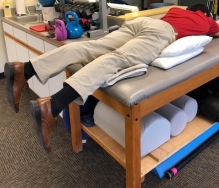
You may also have to take pressure off the healing incisions by rolling up a towel and placing it right above the knee on the distal thigh.
After a few nights, you can try sleeping without the pillow and see how it goes. Just be sure to listen to your body and don’t push yourself too hard.
Sleeping on your stomach may not be possible or comfortable for everyone after a meniscus surgery.
It is important to find a comfortable position for you and that doesn’t put too much pressure on the operated knee.
FAQ About Sleeping After a Knee Arthroscopy
Can you sleep on your stomach after arthroscopic knee surgery?
Sleeping on your stomach may not be possible or comfortable for everyone after a meniscus surgery.
You can sleep on your stomach after surgery; just be sure that your feet hang off the end of the bed to stretch your knee straight while you’re sleeping, and protect the incision.
You may have to place support above the knee to protect the stitches and incisions.
Can you Sleep on Your Side After Meniscus Surgery?
Yes, sleeping on your side is a great position to sleep in after having meniscus surgery.
This will help take some pressure off the operated leg and keep both legs aligned. Just be sure that you have a pillow between your legs to keep pressure off your knee.
How long does the pain last after arthroscopic knee surgery?
This varies considerably on what type of arthroscopic knee surgery was performed. Some surgeries are more painful and are a much longer recovery than others.
For meniscus surgery, most people report pain for the first few days to a week after surgery. However, some people may experience discomfort for several weeks after surgery.
Most people can sleep through the night without waking due to pain within 2-3 weeks.
How Long Should You Ice Your Knee At Night After Surgery?
We typically recommend icing for 20 minutes at a time right before bed.
However, some people may find relief by sleeping with an ice pack on their knees.
You should not leave the ice pack on for more than 20 minutes at a time to avoid tissue damage and should not sleep with the circulating ice machine on for the entirety of the night.
Why is My Knee so Stiff in the Morning After Surgery?
It is common to have a stiff knee in the morning after surgery due to the natural inflammatory process and swelling.
The best way to reduce stiffness is to walk around for a few minutes or ride a bike for a few minutes first thing in the morning.
You also might try to do your home exercise program given to you by your physical therapist to help reduce soreness as quickly as possible.
The soreness and stiffness will gradually improve each day and should be gone within 3-4 weeks.
Can I Sleep with a Pillow Under My Knee
No, you cannot sleep with a pillow underneath the knee. This will keep your knee bent throughout the night.
You can sleep with a long body-length pillow under the entire leg for comfort, but the knee has to be straight.
Do I Need to Wear Compression stockings on my Leg While I Sleep After Knee Surgery?
Yes, for the first 2 weeks, you should wear compressions stockings while you’re sleeping.
Blood clots form when you are not moving the leg, such as when you are asleep, and the blood isn’t circulating as quickly through the body.
The compression stockings help prevent blood clots and help manage swelling through the night.
What to Avoid When Sleeping After Knee Surgery?
These are only a few things you should avoid when sleeping after meniscus surgery.
The first, which we have re-iterated enough on this post already, is to avoid sleeping with a pillow directly underneath the knee and causing it to stay bent for the night. Enough said on that topic.
The others are more minor things to avoid, such as try not to kneel on it when getting into bed for the first week or until the incisions have healed.
Be cautious when rolling over in bed because catching your foot on the sheets can be painful. You likely won’t cause any damage to the surgery, but it simply doesn’t feel great after surgery.
Finally, icing before bed is fine, but do not use ice for the entirety of the night. Icing longer than 20 minutes at a time can negatively affect the blood flow and cause cold-related damage to the surrounding tissue.
Conclusion
Sleeping can be difficult and uncomfortable after a meniscus surgery but following the tips in this article will help make it more bearable.
Be sure to sleep with your knee straight, ice for 20 minutes before bed (if needed), wear compression stockings while sleeping, and avoid sleeping with a pillow directly under the knee.
By following these sleeping tips, you will be well to a full recovery.
Do you have any other sleeping tips that have helped you after knee surgery? Let us know in the comments below what worked well for you and what didn’t.
Disclaimer: The information provided in this post is for educational purposes only. This is not a substitute for a medical appointment. Please refer to your physician before starting any exercise program.
